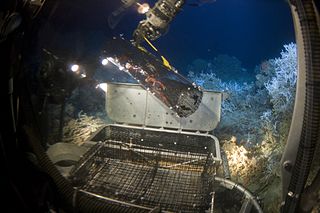Related Research Articles

Plankton are the diverse collection of organisms found in water that are unable to propel themselves against a current. The individual organisms constituting plankton are called plankters. In the ocean, they provide a crucial source of food to many small and large aquatic organisms, such as bivalves, fish and whales.

Gregory Benford is an American science fiction author and astrophysicist who is Professor Emeritus at the Department of Physics and Astronomy at the University of California, Irvine. He is a contributing editor of Reason magazine.

Jellyfish and sea jellies are the informal common names given to the medusa-phase of certain gelatinous members of the subphylum Medusozoa, a major part of the phylum Cnidaria. Jellyfish are mainly free-swimming marine animals with umbrella-shaped bells and trailing tentacles, although a few are anchored to the seabed by stalks rather than being mobile. The bell can pulsate to provide propulsion for highly efficient locomotion. The tentacles are armed with stinging cells and may be used to capture prey and defend against predators. Jellyfish have a complex life cycle; the medusa is normally the sexual phase, which produces planula larva that disperse widely and enter a sedentary polyp phase before reaching sexual maturity.

Monterey Bay Aquarium is a nonprofit public aquarium in Monterey, California. Known for its regional focus on the marine habitats of Monterey Bay, it was the first to exhibit a living kelp forest when it opened in October 1984. Its biologists have pioneered the animal husbandry of jellyfish and it was the first to successfully care for and display a great white shark. The organization's research and conservation efforts also focus on sea otters, various birds, and tunas. Seafood Watch, a sustainable seafood advisory list published by the aquarium beginning in 1999, has influenced the discussion surrounding sustainable seafood.

The Woods Hole Oceanographic Institution is a private, nonprofit research and higher education facility dedicated to the study of marine science and engineering.
The mesopelagiczone, also known as the middle pelagic or twilight zone, is the part of the pelagic zone that lies between the photic epipelagic and the aphotic bathypelagic zones. It is defined by light, and begins at the depth where only 1% of incident light reaches and ends where there is no light; the depths of this zone are between approximately 200 to 1000 meters below the ocean surface. It hosts a diverse biological community that includes bristlemouths, blobfish, bioluminescent jellyfish, giant squid, and myriad other unique organisms adapted to live in a low-light environment. It has long captivated the imagination of scientists, artists and writers; deep sea creatures are prominent in popular culture, particularly as horror movie villains.
Wallace "Wally" Smith Broecker was an American geochemist. He was the Newberry Professor in the Department of Earth and Environmental Sciences at Columbia University, a scientist at Columbia's Lamont-Doherty Earth Observatory and a sustainability fellow at Arizona State University. He developed the idea of a global "conveyor belt" linking the circulation of the global ocean and made major contributions to the science of the carbon cycle and the use of chemical tracers and isotope dating in oceanography. Broecker popularized the term "global warming". He received the Crafoord Prize and the Vetlesen Prize.
Jet propulsion is the propulsion of an object in one direction, produced by ejecting a jet of fluid in the opposite direction. By Newton's third law, the moving body is propelled in the opposite direction to the jet. Reaction engines operating on the principle of jet propulsion include the jet engine used for aircraft propulsion, the pump-jet used for marine propulsion, and the rocket engine and plasma thruster used for spacecraft propulsion. Biological systems include the propulsion mechanisms of certain marine animals such as cephalopods, sea hares, arthropods, and fish.

A salp or salpa is a barrel-shaped, planktic tunicate. It moves by contracting, thereby pumping water through its gelatinous body, one of the most efficient examples of jet propulsion in the animal kingdom. The salp strains the pumped water through its internal feeding filters, feeding on phytoplankton.

Roger Randall Dougan Revelle was a scientist and scholar who was instrumental in the formative years of the University of California San Diego and was among the early scientists to study anthropogenic global warming, as well as the movement of Earth's tectonic plates. UC San Diego's first college is named Revelle College in his honor.
Climate Audit is a blog founded in 2005 by Steve McIntyre.

Deep-sea exploration is the investigation of physical, chemical, and biological conditions on the sea bed, for scientific or commercial purposes. Deep-sea exploration is considered a relatively recent human activity compared to the other areas of geophysical research, as the depths of the sea have been investigated only during comparatively recent years. The ocean depths still remain a largely unexplored part of the planet, and form a relatively undiscovered domain.

Nereus was a hybrid unmanned autonomous underwater vehicle built by the Woods Hole Oceanographic Institution (WHOI). Constructed as a research vehicle to operate at depths of up to 11,000 metres (36,000 ft), it was designed to explore Challenger Deep, the deepest surveyed point in the global ocean. Nereus, named for Greek sea titan Nereus through a nationwide contest of high school and college students, began its deep sea voyage to Challenger Deep in May 2009 and reached the bottom on May 31, 2009.

Gelatinous zooplankton are fragile animals that live in the water column in the ocean. Their delicate bodies have no hard parts and are easily damaged or destroyed. Gelatinous zooplankton are often transparent. All jellyfish are gelatinous zooplankton, but not all gelatinous zooplankton are jellyfish. The most commonly encountered organisms include ctenophores, medusae, salps, and Chaetognatha in coastal waters. However, almost all marine phyla, including Annelida, Mollusca and Arthropoda, contain gelatinous species, but many of those odd species live in the open ocean and the deep sea and are less available to the casual ocean observer. Many gelatinous plankters utilize mucous structures in order to filter feed. Gelatinous zooplankton have also been called "Gelata".

Warren Morton Washington is an American atmospheric scientist, a former chair of the National Science Board, and currently senior scientist at the National Center for Atmospheric Research (NCAR) in Boulder, Colorado.

Global Explorer ROV is a unique deep water remotely operated vehicle that has made numerous dives below 9,000 feet (2,700 m) on science and survey expeditions for National Geographic, the National Oceanographic and Atmospheric Administration (NOAA) and other research organizations. It was designed and built by Chris Nicholson of Deep Sea Systems International, Inc. of Falmouth, Massachusetts.
Harry Leonard Bryden, FRS is an American physical oceanographer, professor at University of Southampton, and staff at the National Oceanography Centre, Southampton. He is best known for his pioneering work in ocean circulation and in the role of the ocean in the Earth's climate.
Robert B. Gagosian is an American oceanographer. In 2016 he is Acting President of the Desert Research Institute in Nevada. Gagosian served as President and CEO of the Consortium for Ocean Leadership in Washington, DC from 2007-2015, where he is currently President Emeritus. Gagosian served as President and Director of the Woods Hole Oceanographic Institution (WHOI) from 1994 to 2006, where he is currently President Emeritus.

Jellyfish blooms are substantial growths in population of species under the phyla Cnidaria and Ctenophora.

David Gruber is an American marine biologist, a Presidential Professor of Biology and Environmental Sciences at Baruch College, City University of New York, and a National Geographic Explorer.
References
- 1 2 3 4 5 6 NOAA website. Retrieved March 31, 2009.
- ↑ Google Scholar search. Retrieved March 31, 2009.
- ↑ Robin Lloyd, "Ocean 'Gummy Bears' Fight Global Warming," LiveScience, July 20, 2006, found at Live Science website. Retrieved March 31, 2009.
- ↑ For example, one area of his research found that salps' fecal pellets may be aggravating global warming. See Kate Melville, "Jellyfish Squish Greenhouse Dogma," July 3, 2006, Lay summary at Science A Go Go website. Retrieved March 31, 2009.